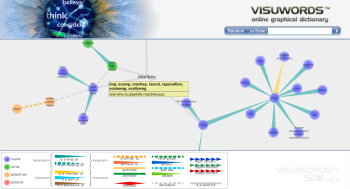Author: Dmitri Popov
Using different command line parameters, you can view lexical data in a number of ways. For example, to view all hypernyms of the word “pirate,” you can use the command wn pirate -hypen, which returns a result that looks something like this:
Sense 1
plagiarist, plagiarizer, plagiariser, literary pirate, pirate => thief, stealer => criminal, felon, crook, outlaw, malefactor => wrongdoer, offender => bad person => person, individual, someone, somebody, mortal, soul => organism, being => living thing, animate thing => object, physical object => physical entity => entity => causal agent, cause, causal agency => physical entity => entity
Instead of using the terminal, you can use the WordNet Browser, but the way it presents the results is only marginally better than the command-line version. But Visuwords, a Flash-based Web application, acts as a better graphical client for WordNet’s lexical data. It displays not only synonyms of the currently viewed word, but also a variety of other lexical relations. Its colorful interface and ability to expand branches make Visuwords a great application for language professionals and anyone remotely interested in language. It’s also a useful tool for those who write for a living.
While you can use the hosted version of Visuwords, the software is also available under an open source license, so you can download and install it on your local server. Better yet, using the XAMPP package, you can run Visuwords off a USB stick.
Installing Visuwords is not particularly difficult as long as you keep in mind a few important details. Download the latest release of the software. The application is a bit finicky about its directory structure, so you must unpack the archive in the visuwords/v2.0 directory. Since Visuwords pulls all the lexical data from the WordNet database, you should also download and install a tarballed version of its latest release. To do this, create a dict folder in the visuwords/v2.0 directory. Grab the WordNet 3.0.tar.gz package, unpack it, and move the following files into the visuwords/v2.0/dict directory: index.sense, data.noun, data.verb, data.adj, data.adv, and lexnames. Then move the entire visuwords directory into your server’s document root and make the visuwords directory writable by the server. Now, point your browser to http://yourserver/visuwords/v2.0/visuwords.swf, and you should see Visuwords in all its beauty.
Using Visuwords is as easy as it gets. Enter a word into the Search field, press Enter, and Visuwords displays a lexical map with the search word in the center. The legend provides explanations of different color codes and connection types, so you can easily identify the type of a particular word and its relations to other words on the map. Hover the mouse over any word on the map, and you see its definition. You can expand the map by double-clicking on any word on it, which allows you to dig deeper into the word maze. This can be rather addictive and inspiring at the same time. You can drag the entire map using the mouse, and you can zoom in and out using the scroll wheel. Both features come in handy when you’re dealing with large lexical maps. You can also stretch and rearrange the nodes by grabbing and dragging them with the mouse.
Visuwords is not only a useful tool for language professionals such as writers, journalists, and linguists. If you are even remotely interested in English, Visuwords can help you to expand your language horizon and explore the lexical intricacies of the English language.
Dmitri Popov is a freelance writer whose articles have appeared in Russian, British, US, German, and Danish computer magazines.
Category:
- Tools & Utilities




